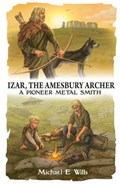What do you think was the most important invention in history?
No, it was not the steam engine, or the aeroplane, or penicillin or even the internet. It was how to change stone into metal! None of the later inventions would have happened without this process.
Copper was the first metal produced. Izar, The Amesbury Archer portrays how knowledge of this vital invention was carried across Europe.
In Salisbury Museum, there is a 4,500 year-old male skeleton. Amazingly, this man died nearly a thousand miles from where he was born. He lived at the end of an era, when human curiosity was pushing the boundaries into a new age. It was an exciting time when dependence on stone gave way to a new, more versatile material – metal.
The numerous items buried with the man give tantalising clues as to his ability as an archer, but also to his role as a pioneer metal worker.
How did this man come to be so far from his homeland, and who, or what, brought him into contact with his apparent trade? What secrets of metallurgy, locked into simple stone, did he learn and how did he use the power that these secrets bestowed upon him? Utilising real-life detail of the burial site and remains, Michael Wills weaves a story that could represent what life was like for this individual, how he lived and how he died. It is an exploration of a time when technology took a great leap forward and helped us to get to where we are today.

